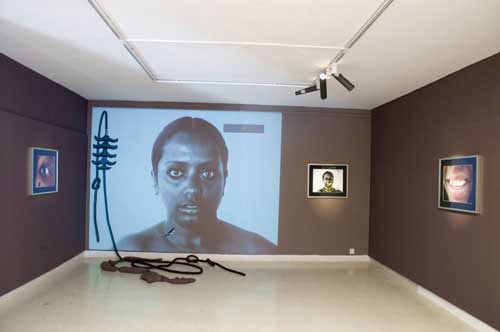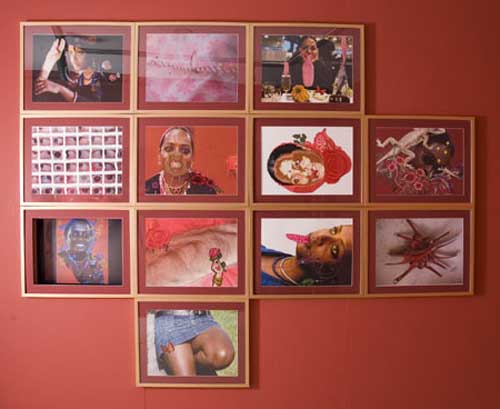LAID OPEN BETWEEN DESIRE AND DISGUST
Mithu Sen's Threshold Poetics
by Alexander Keefe
The she-ghouls have made bracelets from intestines
and red lotus ornaments of women's hands;
have woven necklaces of human hearts
and rouged themselves with blood in place of saffron.
- Bhavabhuti
Mithu Sen's gallery show, Half Full: Part II, reads like a dance of the half dead, a cremation ground lyric, a glasshouse of tropical plants whose skeletal roots are dipped in blood, a dirty joke screamed from the gallows, and a celebration of the turbulent potentialities unlocked by vivisection, dismemberment and display.
There is a candor unfit for the dinner table, an indelicacy unwelcome in mixed company. Like a pornographic SMS, or a threat, or a wink of the eye, some messages deliver more than information, carrying with them non-verbal gifts, incitements, provocation. No wonder these sorts of messages are so often prone to impolite indiscretion, to theft and misuse, to misunderstanding and concealment; if not kept in their place, defanged by convention and politesse, they create awkward moments. More egregiously, they lay bare an intrinsic potential for disobedience latent in all messages—albeit one that typically remains barely manifest, half-hidden beneath the surface. They leave us stripped of the comforting reassurances that polite forms of expression try so hard to deliver: that the means we use to express our innermost selves are no more than the corruptible, external body that we give to the pure, interior soul of our thoughts. But fantasies about controlling our living utterances are just as utopian as fantasies about controlling our bodies: insubordinate messages take on a life of their own, stepping out of line to reach out and touch us without being asked, tickling and provoking us, violating unspoken and unspeakable rules of behavior, whispering dirty secrets about what all messages are always doing, no matter their pretensions of respectability.
Classical Sanskrit aesthetic theorists were wise to warn about the dangerous results of mixing inappropriate and incompatible images—they counsel the poet never to use the word “vomit” when attempting to evoke an erotic mood, for example—because an ill-considered semiotic promiscuity results in bheda, or rupture of mood, just as surely as unregulated intercourse between the social orders disrupts society. But kept safely within the categorical constraints of genre, we enjoy and even invite the evocative power of images and language—everyone likes to cry at the sad scenes in movies, jump when the vampire appears on the screen and laugh at the dwarf and his pratfalls—there is a grammar of sorts that structures and categorizes these moods and, by doing so, renders them accessible for hygienic, aestheticized delectation. Constrained, they structure an inner emotional experience whose anxiously regulated order cooperates with the socially ordered external world our bodies move through. The experience of art so conceived generates the sense of an apparently stable self moving through an apparently stable world of enduring, appropriate, and natural institutions of discipline and control. An aesthetic rupture rips through the fabric of both.
Mithu Sen has created an aesthetic of contact and rupture, sending messages that refuse to stay politely in place, deploying instead an irreverent, disturbing new mythology based on transition and flux, a physics narrated in streams of consciousness that overflow their banks, that circle back and form eddies and whirlpools and sometimes, perversely, run uphill. Instead of the silence and restraint of the courtroom, we hear the jostling, disorderly street. The rules change and vanish in Ms. Sen's threshold poetics: where we expect tears we find laughter, where we expect sacred, pompous awe we find satire and profanation, hierarchies overturned and parodied, rejuvenating violations of decorum, uncontrolled laughter and touching, a world half full and not half empty. Ms. Sen’s art defies simple description—she works in multiple media, combining anatomical abstraction, found art, collage, dark comedy, political polemic, and horrific beauty. Her latest canvases are large, and spill over their velveteen-fringed frames onto the wall. Many are self-portraits of the artist—terrifying half-skeletons dripping with gore, centaur werewomen with eyes fixed on the viewer, pasted with fuzzy paisley stickers, ringed by chattering choruses of hungry scavenging songbirds. Sen's work conducts a sharp, insistent interrogation of the natural, of the taken for granted, of the coercive power latent in images that promise—but always fail to deliver—wholeness, completion, self-identity and repose.

DESTROYED LABYRINTH (2007)
Downstairs, a slippery pile of black, stuffed innards spills out across a wall, and a greedy looking cutout of a pariah kite lurks darkly in the corner, waiting for a mouthful. This installation piece recalls Sen's use of hair as a medium in earlier shows, most notably her "Twilight Zone" installation at Khoj from 2003, and “no Star, no Land, no Word, no Commitment,” an installation done in New York in 2004. But here the line between artificial hair and viscera blackened by exposure is blurred—in subversive violation of the rules of the body, rules that keep some parts in and some parts out. Bodies in Sen's work move between the erotic and the grotesque in an unstable, throbbing hum, leaving the viewer unsettled and open: skin melts into bone, into veins and blood that seep like tendrils, like flowers and hair. The artist tears at the line between desire and disgust, between thick, oiled hair and black, bloated guts—an oscillation between modes of being that won’t allow us to keep them comfortably separate, that won’t allow us the reassurances to be found in that separation.

EPHEMERAL AFFAIR 2 (2007)
Upstairs a video projector illuminates the dark room, beaming a huge black-and-white close-up of the artist's face in motion on the back wall. In it, her face moves in a slowly building set of expressions from relatively uneasy to pained and sick. The camera holds for a minute and then shifts slightly, creating a jarring blur before resuming its hold on the face, as her eyes widen in a wild stare out at the viewer, darting unsteadily to the side and her silent breathing heaves. Watching "Ephemeral Affair" feels like choosing the mosquito hum of a tattoo needle. There is a powerful polemic punch to this show, all the more effective for the artist's remarkable ability to evoke feelings of incompletion and even nausea, transgressing the boundaries of canvas and the spaces between the viewer and viewed.

FALSE FRIENDS 2 (2007)
Like all good subversives, she has a wicked sense of humor. "False Friends 2," a large installation with multiple screens, presents an array of digitally altered, defaced and graffitied photographs, some of the artist traveling abroad, some self-portraits gored with fake blood and stick-on flowers, one of her facing us across a cafe table, a huge fake velvet tongue lolling out of her mouth onto the table. In the lower left corner, a video screen cycles through images set to a ridiculous ersatz Caribbean-ish party jam and we see the artist's face with a bright blue digital mustache wiggling, with crude animations of lizards licking her eyeballs, with her head clumsily photoshopped onto the torso of an absurdly muscle-bound body builder, smiling and bobbing back and forth in time to the music. Here and there sexual organs pop out and disappear. There is comedy here—spoofing on travel photos, YouTube drivel, self-representation, eroticism and disgust—there is a potent anger, and there is madness.

PERHAPS YOU 3 (2007)
The paintings are no less provocative and complex; in "Perhaps You 3" Ms. Sen's smiling face is painted on the shoulders of the decomposing body of a bird surrounded and pecked at by hungry songbirds, its pink entrails exposed to the air and, as though transforming through a kind of oxygen alchemy, they appear gilt with gold. It is a story of halves: the half-dead half-bird with an indecipherable smile allows for no false promises of identity and completion: forms pass from one into the other, moving between self and other, death and life, high and low, guts and gold. This is the radical laughter of the mela grounds, where violations of decorum and proportion shatter the awed silence that is supposed to accompany death, the same awed silence and supernatural terror that greet the arrival of the king and his men, the priest and his books; the grotesque body refuses to cooperate with this solemnity, decrowning it with fantastic transformation and monstrous play. The artist’s body is the theatre for this transformation, but not her body imaged as a series of solid, stable, smooth surfaces; instead, we see a fluxing set of edges, convexities, openings and orifices. The grotesque body is not a completed object; it is something in motion, actively engaged in an unpredictable, incorrigible process of becoming, liberating itself and its viewer from the confines of a world of stable, completed bodies and institutions, estranging her from that apparently finished world guarded by kings and priests where all pretends to remain stable and sane.
The pieces in "Half Full" are hybrids of the present, half-finished, half-humans clawing their way off the wall towards the viewer. Sen's angry graveyard goddesses are moving and hungry, dismembered and dismembering portraits of the dancing undead that reanimate the fertile, liminal landscape of the cremation ground, where once upon a time anonymous lyric poets composed Sanskrit hymns to corpses, and found beauty in scavenging dogs.
View more of Mithu Sen's work here.
Return to table of contents here.
